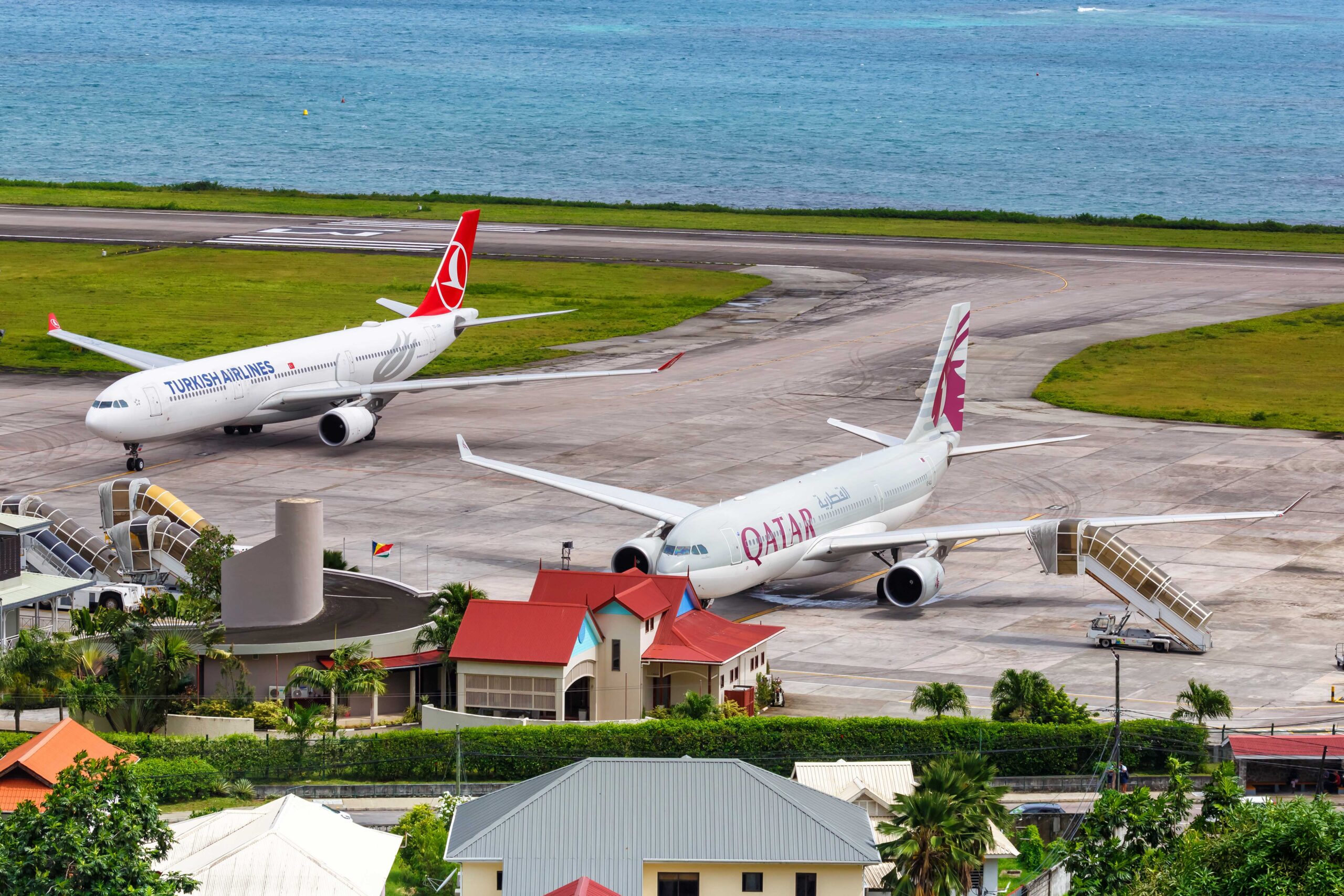The 70% plunge in oil prices back in 2015 sent shockwaves through Middle Eastern economies and other major “black gold” producers, highlighting the urgent need for economic diversification. The crisis was primarily driven by supply factors[i], including booming US production and shifting OPEC policies, which posed significant challenges for oil exporters. In the Middle East, the moment underscored a new policy priority: reducing reliance on oil and developing new sectors that stabilize economies in times of crisis, one such sector being aviation.
Qatar and Türkiye are among those countries that have strategically recognized the aviation industry as a unique and promising avenue, capitalizing on it, not only for commercialization but also as a diplomatic tool. According to an IMF working paper[ii], Qatar experienced relatively high inflation volatility during the oil shock, while Türkiye, despite being a non-oil-exporting country, serves as a strategic transfer hub for oil and natural gas[iii] between Central Asia, the Middle East, and Europe. Weak oil prices can significantly disrupt both economies, making diversification imperative for them.
Although the aviation industry has been relevant in the region for decades, it still has ample room for growth. The wake-up call came in 2015, amid the oil price drop when OAG released data on airline seat occupation using the Available Seat Kilometers (ASKs) metric[iv], which captures the total flight passenger capacity of an airline. The highest growth was observed in the case of Middle Eastern airlines.
The Middle East benefits greatly from its strategic geographical location—situated at the crossroads of Asia, Africa, and Europe—which gives a great advantage in developing a robust aviation sector. This prime positioning also enhances fuel and time efficiency, establishing the region as a global aviation hub. For a long time, the region has served as a technical stop for carriers globally due to cheap fuel prices. Both Qatar and Türkiye transformed to become direct competitors with traditional European transit hubs like Paris, Frankfurt, and Amsterdam. For instance, Hamad Airport of Qatar and Istanbul Airport were named in 2024 as the best and best-connected airports of the world respectively. This recognition underscores the rationale behind both governments’ substantial investment in extensive connectivity infrastructure and stunning airport design. Qatar invested $16 billion in the Hamad International Airport (HIA)[v], which spans 29 square kilometers (11 square miles), with 60% of the land reclaimed from the Arabian Gulf. Meanwhile, Türkiye is investing about $12 billion in Istanbul’s airport expansion[vi], with four phases to be completed by 2025.
In terms of traffic, both airports ranked high in 2024. Istanbul and Hamad are listed among the top 10 busiest airports[vii], repeating their success from the previous year when they were also among the busiest international airports by seat capacity. Istanbul ranks second with 4.2 million passengers, maintaining its top 3 positions from 2023, while Hamad is 10th with 2.6 million passengers. Although Dubai remains comfortably in the top 5, total aircraft movement at Istanbul and Doha is projected to grow significantly compared to it. These numbers also surpass those of notable European airports mentioned earlier.
Qatar also leads with a strong 12.5% investment in the aviation sector[viii], implying a potential doubling in capacity every six years, followed by Türkiye with massive projected revenues and a significant number of aircraft orders.
Aviation diplomacy
Though often underappreciated, aviation diplomacy proves to be a powerful tool in the Middle East in the expansion of public diplomacy and the projection of countries’ soft power, beyond the notable economic benefits. Turkish Airlines facilitates the expansion of Türkiye’s diplomatic relations, especially in the untapped region of Africa. Qatar Airways, on the other hand, demonstrated its commitment to humanitarian assistance during recent crises, showcasing the multifaceted nature of aviation diplomacy that aligns with the country’s foreign policy goal to be seen as a humanitarian leader.
The significance of aviation diplomacy has been established for a long time, with the Bermuda principles inspiring the Bilateral Air Transport Agreement (BATA), which gives countries the flexibility to govern and restrict traffic rights, capacity, tariffs, and designations, reflecting mutual trust and reciprocal commitment, especially in civilian air transport.[ix] Despite criticisms[x] that BATA sectionalizes the world and makes air transport more expensive, it remains relevant, and countries still rely on it. The more BATAs secured, the more open a country is, allowing for more aviation diplomacy. Moreover, with this legal foundation, a broader range of actors can become involved In aviation diplomacy, moving beyond conventional government-to-government interactions under the regime of the ICAO, connecting countries to non-state actors, like IATA, too.
The first case of triumphant aviation diplomacy is Türkiye’s strategic use of Turkish Airlines. The airline’s expansive network covers 130 countries and 266 international destinations. Turkish Airlines has introduced 59 total routes across the African continent[xi] as it secured more BATAs to open routes. For Türkiye, BATAs are not just technical agreements but strategic tools for advancing foreign policy objectives. By securing more BATAs, Turkish Airlines enhances its operational flexibility and strengthens its global presence. One prominent example is Turkish Airlines’ return to Libya in 2024[xii], after suspending operations in 2015 due to the civil war and subsequent security concerns. This is not only a symbol of successful business but also a testament to successful diplomatic negotiation, marked by Foreign Minister Hakan Fidan’s visit to Libya.
The expansion of Turkish Airlines into new markets and regions is directly linked to the successful negotiation and implementation of these agreements. Between 2002 and 2022, Turkish Airlines increased its connectivity by over 50%, a growth trajectory that aligned with Türkiye’s broader diplomatic efforts. This period also saw a significant rise in Turkish embassies in Africa, from only 12 in 2002 to 44 in 2022. This diplomatic expansion underscores the airline’s role in supporting Türkiye’s foreign policy[xiii] and enhancing its global influence.[xiv] Notably, Turkish Airlines’ humanitarian efforts have also amplified its diplomatic impact. In 2017, the airline responded to social media appeals for aid to famine-stricken Somalia[xv], further solidifying its role as a key player in global humanitarian assistance.
In a similar manner, Qatar Airways is part of the country’s soft power strategy.[xvi] Initially intended to lessen Qatar’s dependence on Saudi Arabia in the mid-1990s, Qatar Airways quickly evolved into a powerful tool for promoting the country’s image as an independent soft power, particularly after the opening of Hamad International Airport in 2014. An important element of this is the growing role of Qatar Airways in humanitarian operations as demonstrated during the COVID-19 pandemic.
During the global lockdown, Qatar Airways maintained flights to 30 destinations, repatriating one million stranded individuals and underscoring its role in global crisis management.[xvii] Its operation was also pivotal in evacuating 60,000 people from Afghanistan in 2021[xviii], and delivering $13 million worth of aid to Sudan in 2023[xix] amid escalating violence. The airline’s humanitarian efforts extend through its “WeQare” Environmental, Social, and Governance (ESG) program, launched in response to the global pandemic. This program, in partnership with the UNHCR, utilized Qatar Airways’ fleet to transport up to 400,000 kg of relief items globally.[xx] In 2020 alone, Qatar Airways Cargo transported over 250,000 tonnes of aid and medical supplies. Qatar Airways continued its humanitarian efforts, shipping at least 84,000 tonnes of pharmaceuticals and committing to transport up to 10 tonnes of humanitarian aid under a renewed agreement with the United Nations Office for the Coordination of Humanitarian Affairs (OCHA) in 2024.[xxi]
During the 2022 World Cup in Qatar – as the first country from the Middle East to host the event – Qatar Airways served as the official airline of FIFA (Fédération Internationale de Football Association) and helped engage millions of fans. Qatar Airways reportedly received a massive boost from the FIFA World Cup, carrying 31.7 million passengers[xxii]—a 71% increase over the previous year—even after adjusting existing routes during the event.[xxiii] Hosting the world’s premier football event represents the culmination of Qatar’s vision to display its soft power and its ability to manage international events, benefiting both international tourism and its own economy.
The cases above show that Qatar and Türkiye understand how to capitalize on aviation diplomacy. They recognize the sector as a fast-growing market and are poised for continued growth, much like the industry’s expanding connectivity. While this approach is not without risks, such as geopolitical developments, pandemics, and environmental challenges that impact global capacity and demand, Qatar and Türkiye have proven their commitment to diversification in the long-term.
Conclusion
The effective integration of aviation as part of a country’s strategies for economic and diplomatic purposes underscores the evolving nature of international relations and highlights the importance of aviation diplomacy in the modern geopolitical landscape. By harnessing their airlines’ potential, these countries are charting a course toward sustainable economic resilience and enhanced global influence, moving beyond their reliance on traditional economic sectors. Turkish Airlines and Qatar Airways exemplify how airlines can transcend traditional transportation roles to become significant players in global diplomacy and humanitarian efforts. Through strategic use of Bilateral Air Transport Agreements and humanitarian initiatives, these airlines are reshaping perceptions and fostering diplomatic ties. Their roles extend beyond mere transportation, with an influence on international relations too.
[i] Stocker, M. Baffes, J. and Vorisek, D. (2018). “What triggered the oil price plunge of 2014-2016 and why it failed to deliver an economic impetus in eight charts”, World Bank Blogs, 18 January 2018, retrieved from: https://blogs.worldbank.org/en/developmenttalk/what-triggered-oil-price-plunge-2014-2016-and-why-it-failed-deliver-economic-impetus-eight-charts#:~:text=The%20initial%20drop%20in%20oil,mid%2D2015%20to%20early%202016.
[ii] Grigoli, F., Herman, A. and Swiston, A.J. (2017). “A Crude Shock: Explaining the Impact of the 2014-16 Oil Price Decline Across Exporters”, IMF Working Papers, 18 July 2017, retrieved from: https://www.imf.org/en/Publications/WP/Issues/2017/07/18/A-Crude-Shock-Explaining-the-Impact-of-the-2014-16-Oil-Price-Decline-Across-Exporters-44966.
[iii] U.S. Energy Information Administration (2017). “Country Analysis Brief: Turkey”, 2 February 2017, retrieved from: https://www.eia.gov/international/content/analysis/countries_long/Turkey/turkey.pdf.
[iv] OAG (2024). “Middle East Aviation: Transformation, Growth and Future Challenges”, retrieved from: https://www.oag.com/hubfs/free-reports/2024-reports/Middle-East-Report-2024/Middle-East-Aviation-Report-2024.pdf.
[v] Introba (2024). “New Hamad International Airport”, retrieved from: https://www.introba.com/work/projects/new-hamad-international-airport#:~:text=The%20%2416%20Billion%20Hamad%20International,reclaimed%20from%20the%20Arabian%20Gulf.
[vi] Street, F. (2018). “Istanbul’s new airport aims to be one of world’s largest”, CNN travel, 31 October 2018, retrieved from: https://edition.cnn.com/travel/article/istanbul-new-airport-turkey/index.html.
[vii] OAG (2024). “Busiest Airports in the World”, retrieved from: https://www.oag.com/busiest-airports-world.
[viii] OAG (2024). “Middle East Aviation: Transformation, Growth and Future Challenges”.
[ix] Lissitzyn, O.J. (1964). “Bilateral Agreements on Air Transport”, Journal of Air Law and Commerce, 30(3), 248-263, retrieved from: https://core.ac.uk/download/pdf/147638827.pdf.
[x] Diamond, B.R. (1975). “The Bermuda Agreement Revisited: A Look at the Past, Present and Future of Bilateral Air Transport Agreements”, Journal of Air Law and Commerce, 41(3), 419-496, retrieved from: https://scholar.smu.edu/cgi/viewcontent.cgi?params=/context/jalc/article/2098/&path_info=35_41JAirL_Com419_1975_.pdf.
[xi] Turkish Airlines (2024). “Flight destinations and current flight plan”, retrieved from: https://www.turkishairlines.com/en-int/flight-destinations/.
[xii] Air Service One (2024). “Turkish Airlines has passenger flights to 50 African airports; Libya has returned; narrowbodies are vital”, 15 April 2024, retrieved from: https://airserviceone.com/turkish-airlines-has-passenger-flights-to-50-african-airports-libya-has-returned-narrowbodies-are-vital/.
[xiii] Lebel, J. (2020). “Turkish Airlines: An International Strategic Instrument for Turkey”, IFRI, April 2020, retrieved from: https://www.ifri.org/sites/default/files/atoms/files/lebel_turkish_airlines_2020_complet.pdf.
[xiv] Abdulhayoglu, K. (2019). “Airline Diplomacy: Turkish Airline as an Actor of Public Diplomacy”, ISA Annual Convention 2019, Toronto, 30 March 2019.
[xv] AA (2017). “Turkish Airlines to transport 60 tons of aid to Somalia”, 23 March 2017, retrieved from: https://www.aa.com.tr/en/africa/turkish-airlines-to-transport-60-tons-of-aid-to-somalia/777313#:~:text=Turkish%20Airlines%20will%20send%2060,send%20the%20aid%20to%20Somalia.
[xvi] SWP (2023). “Qatar’s Foreign Policy”, 6 April 2024, retrieved from: https://www.swp-berlin.org/10.18449/2023RP04/.
[xvii] Al Jazeera (2020). “Qatar Airways to resume flights to 80 destinations by June”, 27 May 2020, retrieved from: https://www.aljazeera.com/economy/2020/5/27/qatar-airways-to-resume-flights-to-80-destinations-by-june#:~:text=Qatar%20Airways%20was%20one%20of,30%20destinations%20during%20global%20lockdowns.&text=Qatar%20Airways%20says%20it%20plans,more%20than%2080%20destinations%20worldwide.
[xviii] Pointer, M. (2021). “A Global Response: Qatar”, State Magazine, November 2021, retrieved from: https://statemag.state.gov/2021/11/1121feat01-d/#:~:text=Mission%20OAR%20successfully%20airlifted%20more,travel%20to%20the%20United%20States.
[xix] Map.org (2023). “Collaborative Effort Delivers $13 Million in Critical Medical Aid to Sudan Amid Ongoing Violence”, retrieved from: https://www.map.org/wp-content/uploads/2023/10/Joint-Press-Release_Medical-Shipment-to-Sudan_FINAL.pdf.
[xx] UNHCR (2020). “Qatar Airways”, May 2020, retrieved from: https://www.unhcr.org/about-unhcr/our-partners/private-sector/qatar-airways#:~:text=The%20airline%20will%20provide%20air,its%20charity%20initiative%20’We%20QaRe.
[xxi] Qatar News Agency (2024). “Qatar Airways Joins Forces with United Nations Office for Humanitarian Affairs in New Agreement”, 11 June 2024, retrieved from: https://www.qna.org.qa/en/News-Area/News/2024-06/11/0082-qatar-airways-joins-forces-with-united-nations-office-for-humanitarian-affairs-in-new-agreement.
[xxii] Nagraj, A. (2023). “Fifa World Cup help Qatar Airways post 45% increase in revenue despite lower profit”, 6 July 2023, retrieved from: https://www.thenationalnews.com/business/aviation/2023/07/06/fifa-world-cup-helps-qatar-airways-post-45-increase-in-revenue-despite-lower-profit/.
[xxiii] Nadelet, I. (2022). “Qatar Airways details World Cup network changes”, 31 October 2022, retrieved from: https://www.ch-aviation.com/news/120907-qatar-airways-details-world-cup-network-changes.
















